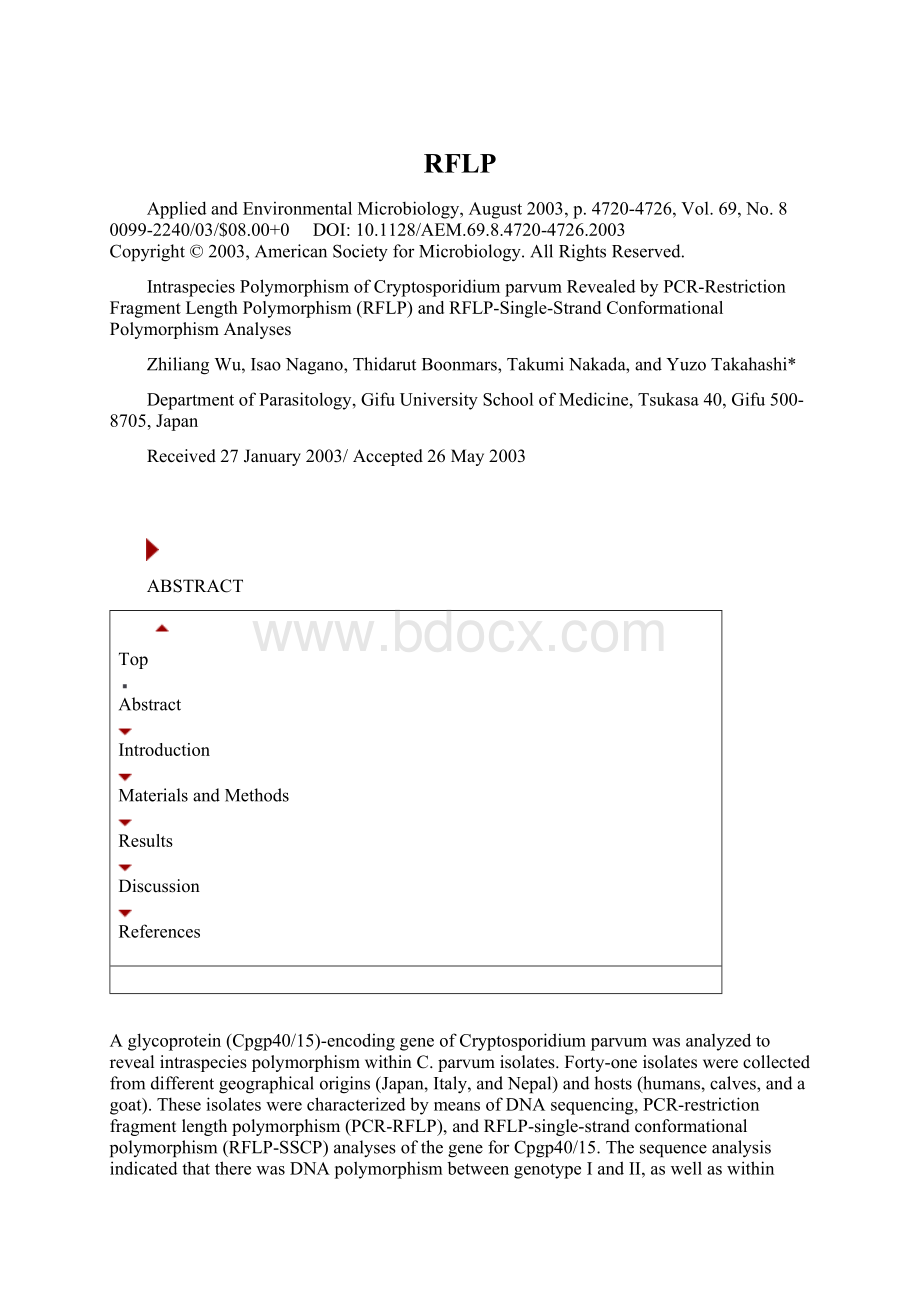RFLPWord格式文档下载.docx
《RFLPWord格式文档下载.docx》由会员分享,可在线阅读,更多相关《RFLPWord格式文档下载.docx(15页珍藏版)》请在冰豆网上搜索。

2003,AmericanSocietyforMicrobiology.AllRightsReserved.
IntraspeciesPolymorphismofCryptosporidiumparvumRevealedbyPCR-RestrictionFragmentLengthPolymorphism(RFLP)andRFLP-Single-StrandConformationalPolymorphismAnalyses
ZhiliangWu,IsaoNagano,ThidarutBoonmars,TakumiNakada,andYuzoTakahashi*
DepartmentofParasitology,GifuUniversitySchoolofMedicine,Tsukasa40,Gifu500-8705,Japan
Received27January2003/Accepted26May2003
ABSTRACT
Top
Abstract
Introduction
MaterialsandMethods
Results
Discussion
References
Aglycoprotein(Cpgp40/15)-encodinggeneofCryptosporidiumparvumwasanalyzedtorevealintraspeciespolymorphismwithinC.parvumisolates.Forty-oneisolateswerecollectedfromdifferentgeographicalorigins(Japan,Italy,andNepal)andhosts(humans,calves,andagoat).TheseisolateswerecharacterizedbymeansofDNAsequencing,PCR-restrictionfragmentlengthpolymorphism(PCR-RFLP),andRFLP-single-strandconformationalpolymorphism(RFLP-SSCP)analysesofthegeneforCpgp40/15.ThesequenceanalysisindicatedthattherewasDNApolymorphismbetweengenotypeIandII,aswellaswithingenotypeI,isolates.TheDNAandaminoacidsequenceidentitiesbetweengenotypesIandIIdiffered,dependingontheisolates,rangingfrom73.3to82.9%and62.4to80.1%,respectively.ThoseamonggenotypeIisolatesdiffered,dependingontheisolates,rangingfrom69.0to85.4%and54.8to79.2%,respectively.BecauseofthehighresolutiongeneratedbyPCR-RFLPandRFLP-SSCP,theisolatesofgenotypeIcouldbesubtypedasgenotypesIa1,Ia2,Ib,andIe.TheisolatesofgenotypeIIcouldbesubtypedasgenotypesIIa,IIb,andIIc.Theisolatesfromcalves,agoat,andoneJapanesehumanwereidentifiedasgenotypeII.WithingenotypeII,theisolatesfromJapanwereidentifiedasgenotypeIIa,thosefromcalvesinItalywereidentifiedasgenotypeIIb,andthegoatisolatewasidentifiedasgenotypeIIc.AllofthegenotypeIisolateswerefromhumans.TheJapaneseisolate(codeno.HJ3)andalloftheNepaleseisolateswereidentifiedasgenotypesIa1andIa2,respectively.TheItalianisolateswereidentifiedasgenotypeIb,andtheJapaneseisolate(codeno.HJ2)wasidentifiedasgenotypeIe.Thus,thePCR-RFLP-SSCPanalysisofthisglycoproteinCpgp40/15genegeneratedahighresolutionthathasnotbeenachievedbypreviousmethodsofgenotypicdifferentiationofC.parvum.
INTRODUCTION
AmongknownCryptosporidiumspp.(seethereviewbyXiaoetal.[19]),Cryptosporidiumparvumissupposedlythemainspeciesthatinfectshumans(7).PreviousstudieshaveshownthatC.parvumismainlycomposedoftwogenotypes,IandII.Theformerhasbeenfoundinhumanpatientsandisthereforereferredtoasthehumantype(5,7).GenotypeIIwasfirstfoundincattleandisthereforereferredtoasthecattletype.Sincethen,however,thistypehasbeenfoundinawiderangeofmammals,includinghumans(4,8).Thus,bothgenotypesareresponsibleforoutbreaksofhumancryptosporidiosisandsporadicinfectionsinimmunocompromisedindividuals(6).
Despiteextensiveearlierstudies,itisstillunclearwhetherthepathogenesis,virulence,infectivity,ordrugsensitivityofCryptosporidiumisrelatedtosomespecificgenotypeornot.Also,genotypicinformationisneededtodetectCryptosporidiumbymeansofPCRfortapwatermonitoringand/ortotracetheinfectionrouteoftheparasite.
Genefingerprintingisapromisingmethodwithwhichtofulfillsuchrequirements.Recently,onegeneencodingaglycoprotein(namedCpgp40/15)ofC.parvumwaslistedasacandidatetargetgeneforgeneticanalysisofC.parvum.SequenceanalysisoftheCpgp40/15geneindicatedthepresenceofpolymorphicvariantswithingenotypeIisolates,whichhavebeendividedintofivesubcategoriessofar(2,11).ThisstudywasundertakentosearchformoreadvantagesoftheCpgp40/15genefortheidentificationandgenefingerprintingofC.parvumisolatesadaptingmoresophisticatedmethods,namely,restrictionfragmentlengthpolymorphism(RFLP)andsingle-strandconformationalpolymorphism(SSCP).
MATERIALSANDMETHODS
Parasiteisolates.
Atotalof41isolatesofC.parvumwereused.SixisolateswerefromcalvesinGifu,Japan(codeno.CGJ1toCGJ6);
11werefromcalvesinKobe,Japan(codeno.CKJ1toCKJ11);
1wasfromacalfinNagoya,Japan(codeno.CNJ1);
8werefromcalvesinItaly(codeno.CI1toCI8);
1wasfromagoatinItaly(codeno.GI1);
3werefromhumansinJapan(codeno.HJ1toHJ3);
5werefromhumansinItaly(codeno.HI1toHI5);
and6werefromhumansinNepal(codeno.HN1toHN6).
Allfecalsampleswerepreservedin2%K2Cr2O7,andoocystswereisolatedbythesucroseflotationmethod.Thesamplesweresubjectedtofurtherpurificationwithanimmunomagneticseparationkit(Dynabeadsanti-Cryptosporidium;
DynalAS,Oslo,Norway).
TemplateDNAforPCRwaspreparedasdescribedpreviously(15).Inbrief,oocystswerefrozenandthawedfivetimesandtreatedat100°
Cfor20min.ThesampleswerethendigestedwithproteinaseKatafinalconcentrationof200µ
g/mlat55°
Cfor3handheatedat95°
Cfor5mintostopthedigestion.Thus-treatedsamplesweredirectlyusedforPCRundertheconditionsdescribedinthefollowingparagraph.
DevelopmentofPCRprimerandPCRconditions.
Apairofprimers(CCGTTATAGTCTCCGCTGTAandAAAGCAGAGGAACCGGCAT)weredevelopedforamplificationofthegeneforCpgy40/15onthebasisofthepublishedsequencedata(GenBankaccessionnumberAF022929)(11).
ThePCRconditionsusedwereasfollows:
1initialdenaturationcycleof94°
Cfor3min;
35cyclesof94°
Cfor30s,54°
Cfor30s,and72°
Cfor1min;
and1finalextensioncycleof72°
Cfor10min.
DNAsequencing.
TheCpgy40/15-encodinggenesfrom16isolates(including8calfisolatesfromJapanandItaly,1goatisolatefromItaly,and7humanisolatesfromJapan,Italy,andNepal)weresequenced.PCRproductswerepurifiedwithaGeneCleanIIKit(Bio101,Carlsbad,Calif.).DNAfragmentswereligatedintoapT7BlueT-Vector(Novagen,Inc.,Madison,Wis.).TherecombinantplasmidswereintroducedintocompetentcellsofEscherichiacoliJM109.TheplasmidDNAwasisolatedfromE.coliwithaFlexiPrepKit(AmershamPharmaciaBiotechInc.,Piscataway,N.J.).
TheDNAwassequencedwithaThermoSequenasecyclesequencingkit(USBCorporation,Cleveland,Ohio)andanautomaticsequencer(LIC-4200;
AlokaCo.,Ltd.).ThesequencedatawereanalyzedwithDNASISsoftware(HitachiSoftwareEngineering,Tokyo,Japan).HomologysearchingofthenucleotideandproteinsequencedatabasewascarriedoutwiththeBLASTprogramattheNationalCenterforBiotechnologyInformation(Bethesda,Md.).PairwisesequencealignmentsandproteinidentitydeterminationswereperformedwithClustalW1.81andPHYLIPDNADISTsoftware.
RFLPandSSCP.
PCR-RFLPanalysiswasperformedaspreviouslydescribed(14,16).PCRproductswerepurifiedbyethanolprecipitationandthendigestedwiththeappropriaterestrictionendonucleases(AluIandRsaI)inaccordancewiththemanufacturer'
sinstructions.
PCR-RFLP-SSCPisahighlysensitivemethoddevelopedbyWuetal.(16).Inbrief,thePCR-RFLPproductwasmixedata1:
1ratiowithdenaturingsolution(95%[vol/vol]formamide,0.02%[wt/vol]xylenecyanol,0.02%[wt/vol]bromophenolblue,20mMEDTA[pH8.0])andheatedat95°
Cfor5min.Thedenaturedsampleswerecoolediniceimmediately.Seven-microlitersampleswereappliedtothegel,andtheDNAsampleswererunat600V,50mA,30W,and10°
Cfor110min.Afterelectrophoresis,thegelwasstainedwithaPlusOneDNAsilverstainingkit(AmershamPharmaciaBiotechAB,Uppsala,Sweden).
RESULTS
AnalysisoftheCpgp40/15gene.
Ofthe41isolates,16fromdifferentgeographicaloriginsandhostswerechosenforDNAsequencing.ThelengthsoftheampliconsproducedbytheprimerdevelopedforCpgy40/15werevariableamongisolates,rangingfrom883to961bp,andtheDNAsequencesoftheampliconswerealsodiverse,asshowninTable1andFig.1.
Viewthistable:
[inthiswindow]
[inanewwindow]
TABLE1.Sequence,PCR-RFLP,andRFLP-SSCPanalysesoftheCpgp40/15geneforgenotypingofC.parvumisolates
Viewlargerversion(85K):
FIG.1.DNAsequencediversitiesamongC.parvumisolatesintheCpgp40/15gene.Thegenesfrom16isolatesweresequencedandtentativelygroupedintoseventypesthatareindicatedontheleftasIIa,IIb,IIc,Ia1,Ia2,Ib,andIe(fortheisolatenames,seeMaterialsandMethods).Dotsindicateidenticalbasepairs,andhyphensindicategaps.ThedifferencesbetweenIIaandIIbandbetweenIa1andIa2areindicatedbyshading.TheGenBankaccessionnumbersareAY167589(CKJ7),AY167590(CI2),AY167591(GI1),AY167594(HJ3),AY167595(HN6),AY167596(HI2),andAY167593(HJ2).
TheDNAsequencesofisolatesfromcalvesfromdifferentgeographicalareasofJapan(codeno.CGJ2,CGJ5,CKJ1,CKJ3,CKJ7,andCNJ1)andonefromahumanpatientinJapan(codeno.HJ1)werequitesimilar,withmorethan99%identity,andwereidentifiedasgenotypeII(Fig.1).
IsolatesfromItaliancalves(codeno.CI2andCI8)showedmorethan98%DNAseq